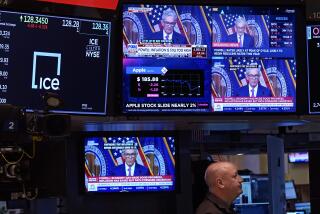Muni bonds now yield next to nothing. Americans keep buying them anyway

- Share via
In theory, the swiftly disappearing yields on municipal bonds should be deterring the little buyers like Greg Fazakerley who dominate the $3.8-trillion market.
That’s not happening. Even before the coronavirus set off a stampede into financial havens, American state and local government debt prices had pushed past the levels once seen as triggers for an investor revolt. The latest panic has given the market a further jolt, with about $2.3 billion sent to municipal-securities mutual funds in early March even as benchmark yields breached the psychological threshold of 1%.
“Taking a look at the monthly statement in municipals, your manager is talking about basis points,” said Fazakerley, a 72-year-old real estate developer who is continuing to buy municipal securities. “We kind of chuckle over a cup of coffee. That’s not where we’re squeezing the lemon to get more juice.”
Americans who already held about $1.9 trillion of state and local debt have poured an additional $113 billion into mutual funds focused on the securities since early 2019, according to Investment Company Institute and Federal Reserve figures. That stepped up buying came even as prices hit new highs relative to Treasurys, yields slid toward more than 60-year lows and fixtures tailored to such buyers — like 5% coupons — were jettisoned, leaving some money managers questioning what threshold, if any, will cause individual investors to retreat.
That faith can be explained by the steady returns the securities have delivered as prices continue to rise, causing buyers to keep stepping up their investments. Overall, municipal securities haven’t lost money since 2013 and last year returned 7.5%, the biggest gain since 2014. Citigroup Inc. analysts said the market has benefited from a self-reinforcing cycle, with positive returns drawing in more cash from individuals.
Starting in early 2018, the demand was increased by the cap President Trump placed on state and local tax deductions. As a consequence, many Americans began using tax-exempt securities as an alternative way to drive down what they owe. The demand received an additional spur this year from a flight-to-quality movement in markets given that defaults by state and local governments were extremely rare even during the last recession. That has driven the yield on 10-year benchmark bonds to about 0.94%, less than one-third of what it was in 2013.
Buyers haven’t been turned off yet. Los Angeles International Airport, rated AA, recently borrowed at below AAA yields, with bonds maturing in 2021 yielding just 0.63%. Even risky debt is paying only what top-rated securities once did. An Ohio agency sold a massive tobacco-settlement bond sale with unrated debt due in 2055 trading at an average of 3.4% yield.
Lewis Appelbaum, a retiree who invests in municipal bonds, said he’s not worried about the sub-1% yields. He estimates he has about 30% of his assets in municipals.
“It’s certainly unattractive, but where would you go?” he said. “Where would you put your money that’s going to be more attractive?”
Retail investors are notoriously bad at timing the market and often move like a herd, plowing in money when the market is going up and pulling back when it falls.
Debra Taylor, who advises high net-worth individuals at Taylor Financial Group in New Jersey, said she isn’t a “fan” of the municipal market given where yields are, but they still make sense for clients who don’t have the right temperament for risk.
Even a 30% or 40% allocation to municipals can make sense for some. “Part of it is a factor of what the alternatives are — not that munis are this incredible, screaming opportunity,” she said.
More to Read
Inside the business of entertainment
The Wide Shot brings you news, analysis and insights on everything from streaming wars to production — and what it all means for the future.
You may occasionally receive promotional content from the Los Angeles Times.










